
NOTE: This unfortunate moment of personal drivel has been moved to a more appropriate place. We apologize for the inconvenience.

NOTE: This unfortunate moment of personal drivel has been moved to a more appropriate place. We apologize for the inconvenience.
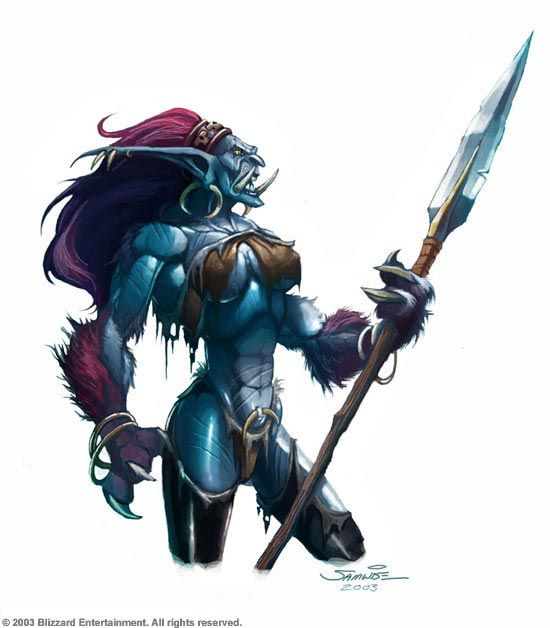
I mentioned in my latest PvP post that I’m thinking of returning to Azeroth in World of Warcraft: Cataclysm. My wife has discussed it as well. Let’s take a look at what Blizzard is doing that’s actually got my attention, and might possibly earn them some of my money, as well. If nothing else, it’s worth considering that this is how my wife & I met, so they must’ve done something right at some point.
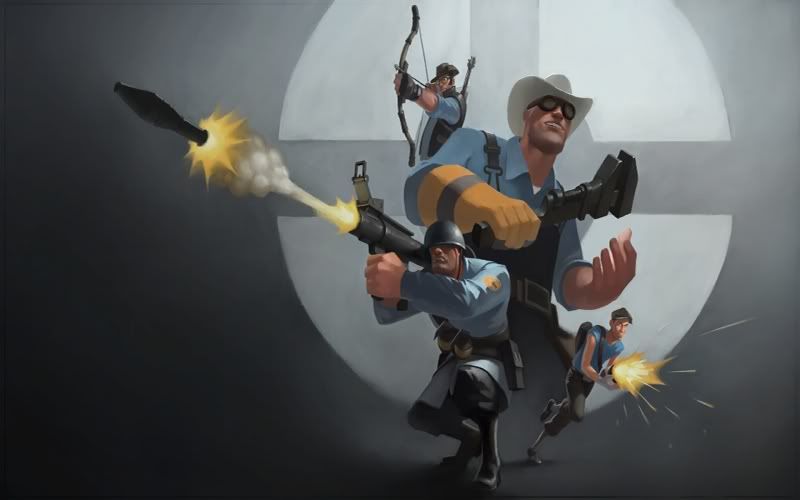
‘Gravel Pit’ is a map in Team Fortress 2. My wife discussed the rated battlegrounds coming to World of Warcraft, and I was immediately reminded of the potential for rated matches in that game, as well. There’s also the fact that, on the superior PC version I’ve yet to play, playing TF2 for any period of time allows you to unlock new equipment. When you get right down to it, how is this any different from rated matches in World of Warcraft?
(Other than the two games being completely different on a fundamental level, yes, I know, shut up.)
One of the things about TF2 that works is when players work together for a common objective. Gravel Pit, for example, is a territory control map where one team (RED) defends while the other (BLU) attacks. You get that in battlegrounds in WoW, but to a lesser extent, since nothing’s really at stake other than personal rating and badges. Arenas do away with the whole overarching objective entirely, since the only real objective is “See those other guys? No, it doesn’t matter who they are or where they’re from. Just beat ’em into a pulp.” It’s not bad in quick bursts now and again, but doing that over and over, for me, gets a bit tedious.
Battlegrounds mix things up. They focus the efforts of a faction on an objective, and while they won’t quite reach the scope of huge open battles in world PvP (or RvR if you will), they still invoke more of that feeling of esprit de corps I talk about. And with the introduction of ratings and the promise of end-level gear every bit as good as what you’d get in arenas, there seems more incentive for me to hop into the queue with the promise to the Alliance to be “a grim bloody fable with an unhappy bloody end.”
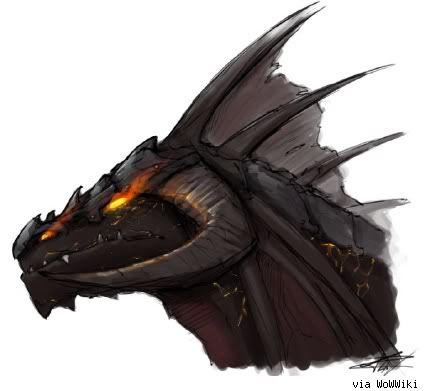
One of my biggest complaints about playing end-game content in World of Warcraft was being a damage dealer tended to be a bit boring. Now, granted, I was playing as a hunter and, according to some, it’s a class that requires the least amount of skill to play. However, in trying to play the class well, I’d worked on things like managing aggro, shot rotation and savvy use of traps.
Most of the end-game dungeons in Wrath of the Lich King took most of those things and threw them from the top of Icecrown Citadel with a deep-throated laugh. Aggro management doesn’t mean squat when the tank generates so much aggro that you could drop a tactical nuclear strike on the mob, or the mob’s hometown, and they’d still have a bigger bone to pick with the tank than with you. Shot rotation still sort of mattered, but only so you wouldn’t have to slow the group down by asking for time to recharge. And traps? Pfft. Who needs crowd control when the tank’s laying down area of effect damage that makes the TF2 demoman’s grenades look like water balloons?
Thankfully, Cataclysm seems to be addressing these issues. In fact, it seems like damage-dealers are going to have to think a bit more when going into dungeons (a scary prospect, I know). Like healers, as my wife mentioned, you’ll need to pay attention to the world around you instead of focusing on the ever-expanding numbers of your DPS meter. There’s a big difference between the knowledge that you’re doing the same thing that 3 other people in the group are doing, and knowing that you need to keep that really ornery ogre over there locked down or else it’ll grab the healer and start beating up the other party members with him or her. It makes the damage-dealer feel more useful, dungeon encounters more exciting and reaching the final boss and blasting them into next week more rewarding.
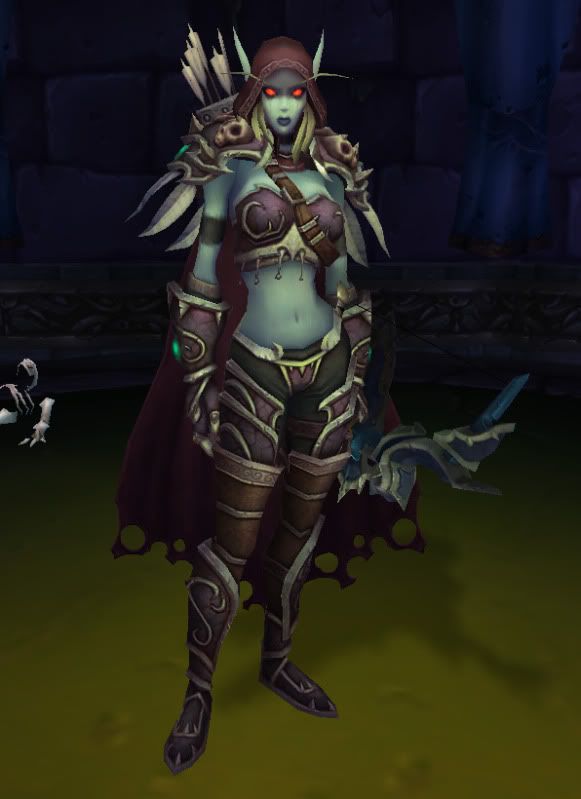
Ever since Warcraft III, I’ve really liked the undead. The unique aesthetic, macabre sense of humor and unorthodox means of waging war all appealed to me. My first Horde character in World of Warcraft, if I recall correctly, was a Forsaken warrior. But I haven’t played Forsaken, really, since Burning Crusade, mostly because when the blood elves were first introduce I went a little bonkers. The blood elves were the faction I liked most in the Frozen Throne, though Sylvanas forming the Forsaken was a very close runner-up in terms of story. Which brings me back to what I’ll be doing when I return to Azeroth.
I’ve never really given the mage class a fair shake. As much as I love the World of Darkness game of the same name (both of them, even if the new one’s thicker and more difficult to digest than a badly made Yorkshire pudding), mages and I have had a tumultuous relationship. I think most of it’s a failing on my part, i.e. being unable to grasp the nuances of handling more than one mob with crowd control spells. With crowd control making a comeback, and considering the likelihood that my wife and I will be playing on an RP-PVP server, it’s time I cleared my mind of other class choices, actually engage my brain while playing the game, and give mages another try. Guns, bows, knives and hammers, to me, will never have anything on “giant laser beam face melty death.”
So I’ll be returning to Azeroth in the slightly decaying skin of a Forsaken mage. I might try a blood elf warrior (they’re spell-breakers, dammit) or a tauren priest at some point (because cows in a dress are hilarious) but getting back to the roots of what I enjoy in Warcraft while trying something I never quite got the hang of before feels like the right way to go.
I have a lot of nostalgia for WoW. I’m hopeful that the proposed changes and updates will move the game back towards what it was when I first started playing, when I met my wife, when I really enjoyed it. I know that Blizzard is continuing to homogenize the classes (eww) and some of the race/class combinations don’t sit well with the established lore and its proponents, like myself (NIGHT ELF MAGES EEEEWWWWW) and I’m definitely staying Horde-side to stay out of the inevitable “Edward or Jacob” discussions that’ll take place between worgen and human players. Ick.
Anyway, the comments section awaits you. Give me your thoughts. Tell me Blizzard just wants another yacht. Offer me and my blushing bride Scrolls of Resurrection. Promise me cake. Even if it, like the idea of 25-man dungeon disappearing being the worst idea ever, is a lie.

[audio:http://www.blueinkalchemy.com/uploads/octagon.mp3]
Ninja…
I wasn’t sure I was going to be doing this. Reviewing a Chuck Norris film from 1980 involves two problems. One is that diehard fans of the martial arts genre might chalk a lot of the problems with The Octagon up to different standards of production and fight choreography from 30 years ago. The other is that saying bad things about Chuck Norris might have fans of the most memetic badass ever to be referenced on the Internet trying to sneak into my bedroom in black pajamas to practice their neck-snapping techniques on something other than the local squirrel population. However, given that the past week has been somewhat chaotic with moving and changing commutes and ensuring my cats know to attack wannabe ninjas on sight, I really have no choice but to review The Octagon.

Chuck Norris is Scott James, a martial artist and former soldier who’s hung up his nunchuks to lead a more peaceful life doing odd jobs and helping out in the community. His last mission put him in the unfortunate position of watching his best friend get murdered, so it’s no surprise that he’s been trying not to punch people in the face to earn a living. However, his past catches up with him when a wealthy & good-looking woman meets him almost by accident and recruits him to take care of some mercenaries who want her dead. It turns out that these mercs are actually part of a vicious group of terrorists who have been trained in the deadly and ancient art of the Ninja, an art Scott himself learned as a boy with his brother, or possibly just a rival, or maybe he’s an Easternized clone or something. He’s played by Tadashi Yamashita. Anyway, it turns out that this other guy from Scott’s past is behind the ninja, and only Scott can punch, kick and slice his way to the truth, or justice, or the end of the plot at the very least.
Let’s get a little praise out of the way first. Chuck Norris knows action. When the scenes that involve Chuck and a fight happen, they’re engaging. It’s nice to know that this was all practical effects and stuntwork. The lack of wire fu and CGI not only means that these guys worked their behinds off to make the scenes work, it also lends an old-fashioned charm to the action. And the action is pretty much all The Octagon has going for it. When you first see Chuck and realize he is without his beard for this film, you know you’re in trouble. He really could have used that extra fist.

This film has a real pacing problem. A long, tedious and overly wordy scene of exposition will cut inexplicably to the training at the ninja camp, which seems like it might be building up to some real tension or at least a bit of action. Then, WHAM, right back to awkward exposition. It makes the film frustrating to watch, and this was after I’d had a few beers in me. Normally at that point I’d be willing to admit that Jumper has some interest effects or that I like Jason Statham and Ray Liotta even when they’re in something like In The Name Of the King while laughing at the badness. I wasn’t laughing at The Octagon. I was too confused to laugh.
At one point, you get to see what good actors and bad actors do in a movie like this. Lee Van Cleef, pretty much the ‘go-to guy’ for classic Western villainy, tries to breathe a little life into his role and the film in general with his smirking gun-loving militia type character. On the other end of things, you have Karen Carlson, and… wow. If you ever feel the need to suffer through a performance that makes Hayden Christensen look like Harrison Ford, look no further. Using the words ‘stiff’ and ‘wooden’ to describe this woman’s work in this film would incur the wrath of corpses and trees alike, and I’ve already got to be on the lookout for ninjas. Her character is an utter contrivance, a walking plot device of the worst kind and she just sucks what little life there is right off of the screen. Those overly long and tedious expository scenes I mentioned that make you forget this is a martial arts flick? She’s in most of those. And Chuck looks just as bored as we feel when he’s in them.
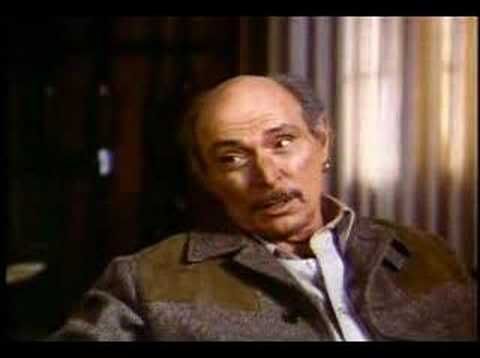
Speaking of Chuck, if The Octagon is to be believed, there’s a huge echo chamber in his head. When we hear Scott’s inner monologue, it’s in a hushed tone of voice that bounces around between the speakers because apparently the makers of this film wouldn’t know good storytelling if it sat in their laps and offered a happy ending. Instead of showing us the moral conflict of the protagonist through any number of film-making tools, Chuck narrates his character’s feelings, and his tone of voice is so soft, the echo so ridiculous and the accompanying score so melodramatic that you need specialized ninja training just to understand what the fuck is going on. We are told things, over and over again, instead of being shown, and this extremely bad form of telling a story coupled with the tedious expository scenes and inexplicable jumps between locations makes the whole affair almost sickening in its badness.
After over an hour of this crap I was ready to consider the whole thing a failure on the scale of Attack Of The Clones. But at the very end, The Octagon seems to wake up from some sort of ninja-induced torpor and suddenly starts kicking ass. Well, Chuck does, at least. The last twenty minutes of this film has somewhat decent action, with Mister Norris infiltrating the ninja camp and confronting Yamashita-san. There’s a hefty dash of good atmosphere, some suspense and even a little drama. However, when the confrontation is over, so is the movie. It’s an ending so abrupt and inexplicable I can’t even put it into words. Also, when the climax occurs it’s clearly nighttime, but after the fight ends we see Chuck Norris sihouetted against what it clearly a sunset. Did the director think that a sunset and a sunrise were interchangable? Did they believe that fans of Chuck Norris would be too dazed by post-masturbation afterglow to notice the difference? Were they high?
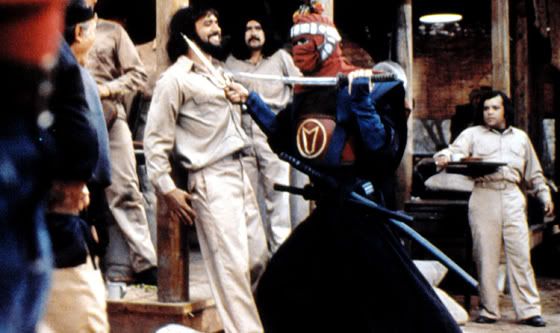
We also get no real explanation as to how the conflict between Chuck and Tadashi began. We see what we assume is a mini-Chuck and mini-Tadashi being trained in flashbacks, with rivalry and lessons learned blah blah faux brotherhood blah blah I will never forgive you blee. I was reminded of the rivalry between Ken & Ryu in the Street Fighter series of video games, and you know what? I’ve read Street Fighter fanfiction with better characterization, pacing and action than this film, and no I’m not talking about that one where Zangief bends Blanka over a bench press. Or where Cammy is telling Chun-Li she doesn’t need a man in her life and can take care of her own needs. Wait, what was I talking about? Oh, right, The Octagon.
The forum in which I saw The Octagon was perfect. There were lots of friends, beer aplenty, and easy access to the bathroom should vomiting commence. Do NOT watch this film alone. Not even the mighty roundhouse-kick-to-the-face beats-the-odds-with-his-fists kidney-liquefying-glare-delivering power of Chuck Norris can save it. If you can find a way to just watch the last 20 minutes without sitting through the awful first three quarters, that’d be a fun lunch break. But you might still want someone to watch your back. You never know when your viewing of a film involving ninjas that reveals their secret, ancient and deadly training will be interrupted with a ninja sneaking into the room and breaking your neck.
Josh Loomis can’t always make it to the local megaplex, and thus must turn to alternative forms of cinematic entertainment. There might not be overpriced soda pop & over-buttered popcorn, and it’s unclear if this week’s film came in the mail or was delivered via the dark & mysterious tubes of the Internet. Only one thing is certain… IT CAME FROM NETFLIX.
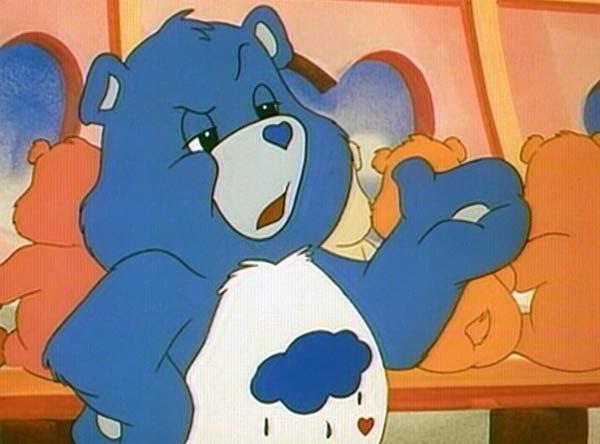
I’ve been accused, in the past, of being something of a care bear when it comes to PvP content in games. Thankfully, there’s help, even for someone like me. I’m slowly rediscovering what it means to take joy in the misery of other players, thanks to my return to Team Fortress 2. Along with a resurgence of a competitive nature that more often than not takes the form of a stream of expletives, as 2Fort is SRS BZNS*, it’s given me cause to think about what makes good and not-so-good PvP content in both tabletop and on-line games.
In single-player games, it’s good to have a single villain or a group of antagonists that clearly stand between the player and their objective. And straight-forward dungeon crawls often benefit from pitting multiple players against a single intelligence, be it a human GM or a programmed AI that respawns enemies as you click your way around the dark tunnels. As much as the Steam game Torchlight evokes the nostalgia of hours spent exploring the many and varied underground demon-guarded caches of loot in Diablo II, it misses the benefits of many people diving into the game to face more powerful enemies in the name of grabbing shinier equipment. But I’m wandering off my point, which is that in those cases, it’s good to have a single bad guy. But what happens when your potential player base expands beyond a handful of intrepid adventurers?
Sometimes, you just have to pit one group of adventurers against another. There are a few ways to do this.
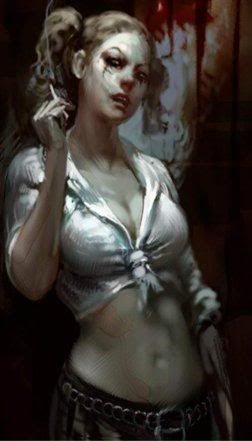
In the old World of Darkness, most notably in Vampre: The Masquerade, factions were a completely player-based thing. While the threat of the Antideluvians coming back to life and consuming their children in an orgy of blood-fueled Armageddon was an ever-constant threat, most of the night-to-night problems were caused by one group of vampires (the Camarilla) fighting against the other (the Sabbat). What was the cause of this conflict, you ask? The Sabbat’s evil.
Now, no vampire can really be described as 100% “good,” no matter what Team Edward might say. Even your most approachable and human-friendly blood-sucking fiend is still a blood-sucking fiend.
But if the Camarilla are vampires who talk nice to their cows before killing them in a humane way in order to carve them into delicious well-made marinated steaks, the Sabbat laugh as they kick the cows mooing into a giant meat grinder to churn out the greasiest, nastiest, cheapest “heart-attack-on-a-bun” burgers possible, selling them to the public at $10 US a pop as ‘classic American hamburgers’. There may or may not be babies in there, too. Baby cows, hopefully. Though I wouldn’t rule out kittens.
This conflict is built into the core game. There’s no ambiguity or much room for interpretation, one side’s less evil and more amenable towards humanity, while the other is thoroughly nasty and definitely not family-friendly. While it can be fun to be the bad guy every now and again, having your entire motivation be puppy-punting grandma-incinerating nastiness all day every day gets a bit old after a while. Which might be why that game ended.
Anyway, future iterations of the World of Darkness would see factions be more ambiguous in certain ways, and rather than saying “X and Y are locked into AN ETERNAL STRUGGLE FOR SUPREMACY UNTIL KINGDOM COME,” it’s much more “Here are some factions you guys can play in. Decide for yourselves how they get along. Have fun!”
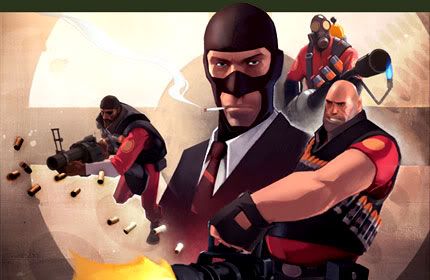
Team Fortress 2 is a bit like that. Neither RED nor BLU is clearly defined as being on one side or the other of the “Good/Evil” scale. Leaving aside the role the Announcer may or may not play in the conflict, the motivations of the teams pretty much boil down to healthy competition. With live ammunition and sharp objects. Not to mention explosives.
Anyway, the point is that it’s up to individual players to fill in the blanks. It’s a straightforward, simple system that works well in on-line shooters. It could almost be considered the polar opposite of the strict pigeonholing of the old World of Darkness. When you get into on-line games involving more than a few dozen players, though, things get a bit more complex.

World of Warcraft and Aion have something in common. The players in these games select one of two factions, which are essentially flip sides of the same coin. They do fight each other, but larger external threats demand the attention of both sides and can sometimes lead to alliances of convenience (the Wrathgate in WoW for example). This allows players access to both PvP and PvE play styles, and interested parties can either strike a balance of time between both, or eschew one entirely in pursuit of excellence in the other. Or people can do what I used to do, which is fart around on dailies trying to earn enough money for a flying mount that’s only slightly faster than one I could build with my bare hands as an Engineer.
More on this when I discuss World of Warcraft more in-depth on Saturday. There’s change coming, and it might be good. Good enough to return to Azeroth? The jury’s still out.
Basically, when you want to engender player-versus-player conflict in your games, be it on the table or through the Intertubes, it’s best to let it grow on its own. Give players fields in which to compete and let them go at it. There’s really no need to give them motivations other than “they’re not on our side.” However, if you want to give the other side a nudge, just hit ’em with incriminating photos of a family member. Their mom, for instance.
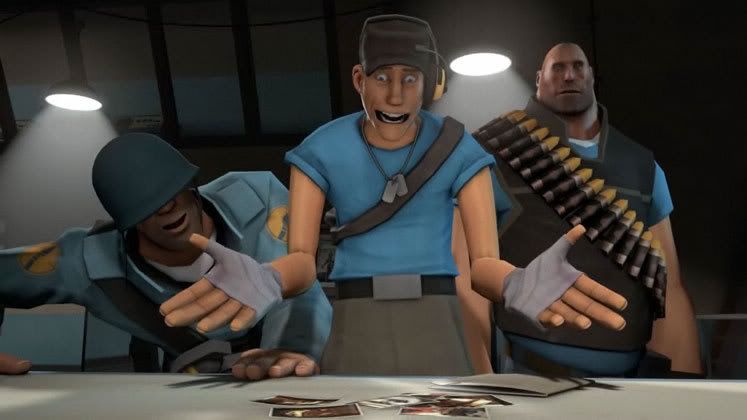
*No, not really.

I’ve been inspired to write the following due to Alex Macris’ latest Check for Traps feature on the Escapist. You can read it here. The Cliff’s Notes is basically that a GM in a tabletop RPG should be less of a directive storyteller, and more of an emergent one. That’s a great concept in theory, but it’s possible for some GMs to consider this an excuse to do no story work whatsoever and that, my friends, is a mistake.
Characters with no story to bring them together or drive them forward is like ribs without a spine. Now, as a food, ribs without a spine are mostly what you’re looking for. Lather those ribs in a delicious sauce and cook them just right so that the meat’s nice and moist rather than tough and dry, and you have yourself a delicacy for a discerning omnivore such as myself. But even in those ideal conditions, the end result’s a bit messy.
A less food-based example of what I’m talking about is Mass Effect 2.
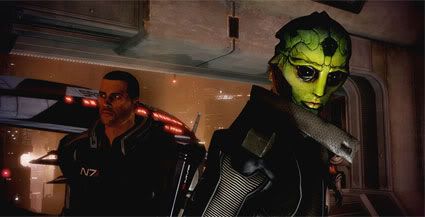
For most of the game, you go from one hot spot in the galaxy to another, either picking up a new member of your crew or helping them with a personal matter to earn their undying loyalty (for the most part). This series of mini-stories is bookended with the whole Reapers/Collectors business, but the nature of the game leads one to believe that they’re more of a backdrop against which the characters grow, rather than being any sort of impetus for change or tension. If the plot had been more coherent or the threat more credible, we might have had a more full-bodied experience rather than a plate of (albeit tasty) character ribs.
When you have strong characters, the story holding them together should also be strong. However, it shouldn’t overwhelm the characters. I think that’s what Alex has been driving at in his last few articles. The guy behind the screen, the man behind the curtain, the puppeteer above the stage pulling the strings – it shouldn’t be all about them and the story they want to tell to the exclusion of everything else. Role-playing games involving more than one player should be collaborative experiences, with players bringing interesting characters to the table while the GM weaves their plots together and gives them something against which to struggle. That is unless you’re running a demo at a convention or something and just want to show off how cool this dungeon is or how that class works in comparison to that other class. Then you go straight for the mechanics and rules, and leave most of your story-telling and world-building and atmosphere-creating tools at home. I learned that one the hard way.
See what I mean here? Are you catching my drift? Or am I completely off my rocker because I told those kids to get off my lawn a bit too violently? Share your thoughts, Intertubes.
© 2024 Blue Ink Alchemy
Theme by Anders Noren — Up ↑